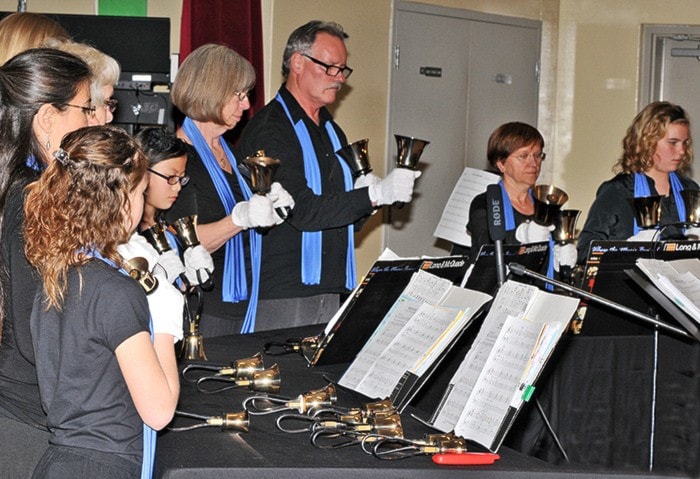The Cache Creek and Ashcroft area can rightly boast of it’s enthusiastic and varied music and entertainment groups, made up of talented local members.
The Cache Creek Desert Hand Bell Choir began in 2011 as a mother’s way of providing for her child’s happiness.
Hand Bell director Carmen Ranta said it started when she, her husband and daughter Elizabeth attended a Christmas Symphony in Kamloops one year.
“I had hoped she would fall in love with an instrument that she could learn,” says Ranta. “But instead of the violin or cello which I had hoped for, she fell in love with the hand bells.”
Ranta said she didn’t want to be driving her daughter into Kamloops for rehearsals, but she wanted to give her a way to learn the musical instrument of her choice. That’s when her husband John looked at her and said, “Why don’t you start your own handbell choir?”
The school district had an old set of hand bells that were housed in Lillooet. They were used in the 1970s but had fallen silent.
Only one person answered her call to start a hand bell choir at first. She held practices and the numbers grew slowly. Ranta said she was ready to throw in the towel, but one of her ringers, Maria Russell Martin refused to take ‘no’ for an answer and brought two more people with her.
Their first concert was Christmas 2013 at St. Albans. Six ringers played three Christmas carols, one single note at a time.
Ranta says they invited the audience to come up and try the bells after the concert was over and they added six more ringers to the choir.
They used the borrowed bells for almost a year and a half. Then others became interested in them and the choir didn’t always have access to them.
Then word came of a used set available from a seniors centre in Lower Mainland. Ranta said it’s almost unheard of to find a full set of used bells for sale. She went to look at them and brought them home.
“We thought we’d be without a set of bells so this was perfect timing,” she said.
But it didn’t end there. Retired Lillooet teacher Lynn Albertson had always supported the group. Her mother, Helene, had been a hand bell director for many years and Albertson provided the choir with music and other items that had belonged to her mother.
After purchasing the Lower Mainland hand bells, Ranta realized they were Helene’s old bells.
“That was such an amazing co-incidence,” says Ranta. “Hand bells and music were re-united.”
Since then, the 33 bells have been back to their original makers, Schulmerich Carillons in Massachusets for overhaul. The group has also added mallets to their repertoire, and Ranta says they will be adding a set of hand chimes next.
She says they add a sound that’s both mysterious and mellow and can accompany the bells with a different melodic line.
The school district’s bells are back in Lillooet. Ranta says she hopes that another group will form there, and the Desert Bells has donated foam for the tables that the bells sit on.
Hand bell groups are few and far between in BC and most are seniors groups that are based out of churches. The Desert Bells are open to everyone and have had members from 9 years old to 80.
They practice regularly throughout the Fall and Spring, and include music theory as well as the music iteslf.
“We’re always looking to improve as musicians and as people,” says Ranta.
The Choir currently has 11 members and they now play about five concerts a year, including one in Kamloops.
“The ringers are very enthusiastic,” says Ranta. “Most didn’t read music when they joined.”
But with hand bells, you’re always playing a line note or a space note, she says. As long as you know your own note, you just have to wait for it.
“That is an interesting way to put it,” says long-time Choir member Maria Russell Martin, - ‘waiting’. Yet, you are so focussed on ‘waiting’ for your note that at times it feels like nano seconds.”
She says the ringers are reading reading everyone else’s notes so the brain is working furiously.
“At least mine is,” she says, “physically and mentally. Some songs may feature your note so you play it more frequently and of course the timing/counting can be tricky.
“We are like a human piano and Carmen is tinkling our notes. We need to be in that moment or we lose our chance to make that note ring!”
Hand bells are descendants from the tower bells in England. Around the 16th Century, the art of tower bell ringing was becoming established: a set of five to 12 bells was rung in a numerical sequence as opposed to melodic pattern. This was called “change ringing”.
It took hours of practice of pulling on the ropes that caused the bells to ring in different orders, creating the intricate patterns of melody. All of this practice was disturbing the neighbours, so smaller bells were created to practice on. It had the added benefit of allowing the ringer to practice in a warm hall rather than a cold bell tower.
Eventually, this type of bell ringing became an art in itself and larger sets of hand bells were cast. “Tune ringing” came into vogue around the middle of the 19th Century and it gradually made its way to North America.
“I love the practices,” says Russell Martin, “especially when we get ‘it’ all together. There is such a sense of accomplishment and joy that only music can bring.”
Vancouver will host the 2016 international hand bell conference, bringing thousands of hand bell ringers together, many of them playing. Ranta says that’s exciting for choir members. The event is being organized by the BC Guild of English Hand Bell Ringers and the Desert Bells have been asked to volunteer at it.
